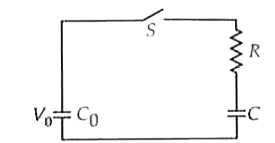A
B
C
D
Text Solution
Verified by Experts
The correct Answer is:
|
Topper's Solved these Questions
ELECTROSTATICS
MTG-WBJEE|Exercise (WB JEE Previous Years Questions ) CATEGORY 2 : Single Option correct Type|8 VideosView PlaylistELECTROSTATICS
MTG-WBJEE|Exercise (WB JEE Previous Years Questions ) CATEGORY 3 : One or More than One Opion correct Type|4 VideosView PlaylistELECTROSTATICS
MTG-WBJEE|Exercise (WB JEE / WORKOUT )CATEGORY 3 : One or More than One Option Correct Type (2 Marks)|10 VideosView PlaylistELECTROMAGNETIC WAVES
MTG-WBJEE|Exercise WB JEE WORKOUT (CATEGORY 3 : ONE OR MORE THAN ONE OPTION CORRECT TYPE)|10 VideosView PlaylistGRAVITATION
MTG-WBJEE|Exercise WB JEE Previous Years Questions (CATEGORY 1: Single Option Correct Type|7 VideosView Playlist
Similar Questions
Explore conceptually related problems
Knowledge Check
Similar Questions
Explore conceptually related problems
MTG-WBJEE-ELECTROSTATICS-(WB JEE Previous Years Questions ) CATEGORY 1 : Single Option correct Type
- A capacitor of capacitance C(0) is charged to a potential V(0) and is ...
Text Solution
|
Playing Now - As shown in the figure a charge +2 C is situated at the origin O and ...
03:11
|
Play - A particle of mass M and charge q is released from rest in a region of...
Text Solution
|
Play - Four identical plates each of area a are separated by a distance d. Th...
Text Solution
|
Play - A particle of mass M and charge q , initially at rest , is accelerated...
Text Solution
|
Play - Three capacitors 3 muF, 6 muF and 6 muF are connected in series to sou...
03:33
|
Play - An infinite sheet carrying a uniform surface charge density sigma1 li...
Text Solution
|
Play - Consider two concentric spherical metal shells of radii r(1) and r(2) ...
01:27
|
Play - A parallel plate capacitor is charged and the charging battery is then...
03:16
|
Play - A 5muF capacitor is connected in series with a 10muF capacitor. When a...
03:33
|
Play - The line AA' is on a charged infinite conducting plane which is perpen...
03:37
|
Play - Angle between an equipotential surface and electric lines of force is
02:47
|
Play - Equivalent capacitance between A and B in the figure is
Text Solution
|
Play - A hollow metal sphere of radius R is charged with a charge Q. The elec...
02:02
|
Play - A positive charge Q is situated at the centre of cube. The electric f...
02:05
|
Play - Three capacitors of capacitacnce 1.0, 2.0 and 5.0muF are connected in ...
02:40
|
Play - A charge of 0.8C is divided into two charges Q(1) and Q(2). These are ...
04:26
|
Play - A point charge -q is carried from a point A to anther point B on the a...
05:03
|
Play - A charged particle q is placed at the centre O of cube of length L(A B...
02:32
|
Play - Four equal charges of value +Q are placed at any four vertices of a re...
03:42
|
Play
